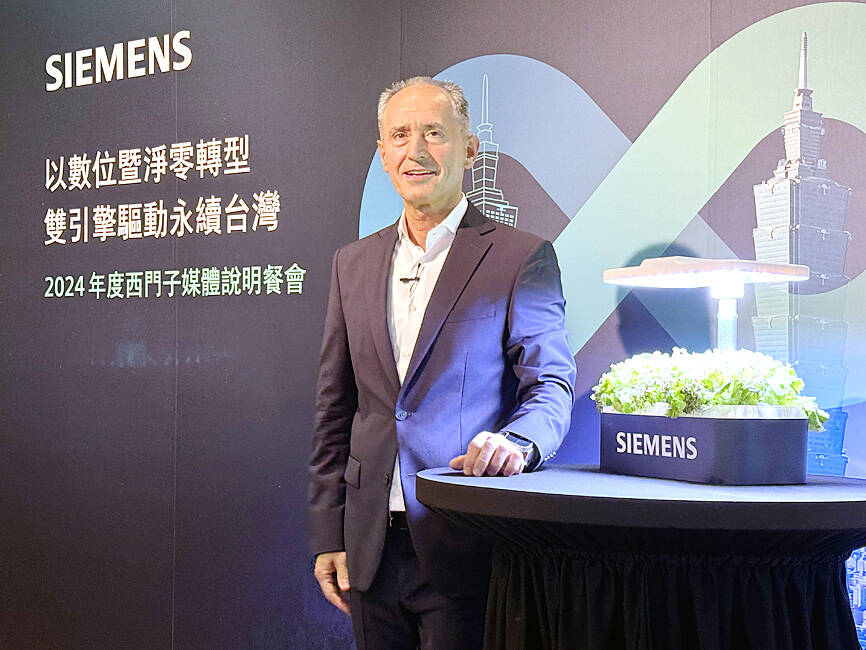Siemens Taiwan Ltd aims to grow its revenue at a pace that is twice as fast as Taiwan’s GDP growth this year, as local semiconductor companies are eager to optimize energy efficiency and install automation systems to enhance operational efficiency, the firm said yesterday.
Led by Taiwan Semiconductor Manufacturing Co (台積電), the chip sector is a key revenue contributor to Siemens, as semiconductor companies depend on the German firm’s automation, energy management and IC design solutions to optimize product and production designs.
“It is our goal to grow. We hope our growth will double Taiwan’s GDP growth,” Siemens Taiwan president and chief executive officer Erdal Elver said in Taipei. “The first half [of this year] will still be in the recovery phase, but we do expect the second half to get better.”

Photo: CNA
Taiwan’s economy is expected to grow 3.43 percent this year, accelerating from a 1.31 percent expansion last year, the Directorate-General of Budget, Accounting and Statistics forecast.
Over the past decade, Siemens has been growing its business at a rate of double Taiwan’s GDP growth, thanks to greater exposure to key areas such as renewable energy and smart cities, it said.
Siemens Taiwan also expects more exposure to public infrastructure such as mass rapid transit systems, power plants and new construction projects, Elver said.
Last year, Siemens Taiwan’s business in the manufacturing category dropped slightly as a weak global economy, US-China trade disputes and geopolitical tensions weighed on customers’ business, Elver said.
Siemens Taiwan’s manufacturing business is to improve this year, thanks to a pickup in macroeconomic situations, but it might take time for local manufacturers to restart full-scale investments in digital transformation, he said.
Siemens Taiwan has assisted Evergreen Marine Corp (長榮海運) in establishing the nation’s first fully automated port, enabling the shipping company to address challenges with larger ships and equipment, managing workloads and efficient energy consumption, it said.
The firm also helped Hota Industrial Manufacturing Co (和大) maximize productivity through artificial intelligence smart learning, and assisted Taiwan Power Co (台電) in enhancing power grid resilience and energy stability, it added.

When an apartment comes up for rent in Germany’s big cities, hundreds of prospective tenants often queue down the street to view it, but the acute shortage of affordable housing is getting scant attention ahead of today’s snap general election. “Housing is one of the main problems for people, but nobody talks about it, nobody takes it seriously,” said Andreas Ibel, president of Build Europe, an association representing housing developers. Migration and the sluggish economy top the list of voters’ concerns, but analysts say housing policy fails to break through as returns on investment take time to register, making the

NOT TO WORRY: Some people are concerned funds might continue moving out of the country, but the central bank said financial account outflows are not unusual in Taiwan Taiwan’s outbound investments hit a new high last year due to investments made by contract chipmaker Taiwan Semiconductor Manufacturing Co (TSMC, 台積電) and other major manufacturers to boost global expansion, the central bank said on Thursday. The net increase in outbound investments last year reached a record US$21.05 billion, while the net increase in outbound investments by Taiwanese residents reached a record US$31.98 billion, central bank data showed. Chen Fei-wen (陳斐紋), deputy director of the central bank’s Department of Economic Research, said the increase was largely due to TSMC’s efforts to expand production in the US and Japan. Investments by Vanguard International

WARNING SHOT: The US president has threatened to impose 25 percent tariffs on all imported vehicles, and similar or higher duties on pharmaceuticals and semiconductors US President Donald Trump on Wednesday suggested that a trade deal with China was “possible” — a key target in the US leader’s tariffs policy. The US in 2020 had already agreed to “a great trade deal with China” and a new deal was “possible,” Trump said. Trump said he expected Chinese President Xi Jinping (習近平) to visit the US, without giving a timeline for his trip. Trump also said that he was talking to China about TikTok, as the US seeks to broker a sale of the popular app owned by Chinese firm ByteDance Ltd (字節跳動). Trump last week said that he had

STRUGGLING TO SURVIVE: The group is proposing a consortium of investors, with Tesla as the largest backer, and possibly a minority investment by Hon Hai Precision Nissan Motor Co shares jumped after the Financial Times reported that a high-level Japanese group has drawn up plans to seek investment from Elon Musk’s Tesla Inc to aid the struggling automaker. The group believes the electric vehicle (EV) maker is interested in acquiring Nissan’s plants in the US, the newspaper reported, citing people it did not identify. The proposal envisions a consortium of investors, with Tesla as the largest backer, but also includes the possibility of a minority investment by Hon Hai Precision Industry Co (鴻海精密) to prevent a full takeover by the Apple supplier, the report said. The group is